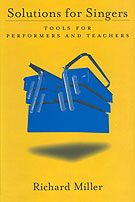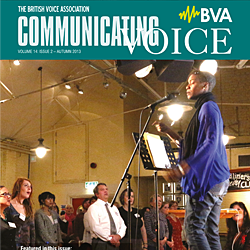About the Association
Archived book reviews
 Solutions for Singers
Solutions for Singers
Richard Miller
Oxford University Press 2004
Review by: Gordon Stewart
Richard Miller is following a great predecessor in casting his latest book in question and answer form. It's the form used in one of his books by Manuel Garcia, inventor of the laryngoscope and singing teacher, and a rôle-model for later singing teachers, especially those who have come to believe, as he did, that science is important in a profession which until then had twitched its skirts away from a contact they thought might prove uncomfortable.
It's very important to say that Dr Miller has become a well-known character in singing pedagogy, through collaboration with the scientific and physiological experts in voice, some well known in BVA circles. He is a respected teacher who travels the world sharing his advice and knowledge, very much in demand on what I call the Flying Doctor circuit, involving as it does flying in, giving classes, and flying out again. His books - he is a 'prolific author', as the book-cover says - are on many shelves. I have one.
The drum that the dust jacket beats is one that must embarrass Dr Miller, such are the claims it makes. But there it is, the publishers believe that the aim of this, his latest book, is one of 'filling in gaps that professional performers, students of singing, and voice teachers have long sought to close'. Of course, there's a lot of truth in the book, and the gaps suggested by the dust jacket aren't always gaps. Quite a lot of what's here is common knowledge.
The format is of a much-expanded version of the question time you get at the end of a presentation. More than two hundred questions are dealt with, sorted into eight major categories - breath management, posture, laryngeal and intralaryngeal function, resonance balancing, and so on. There is cross referencing (See Elevating and Lowering the Larynx) but no alphabetical index to help you pursue those instructions. It is inevitably something of a ragbag, because the book depends on the questions that have been asked (unless some of them have been planted, of course). The answers are sometimes not structured, but the best contain information on a physiological level. That tends to be followed by the Miller version of how to interpret those facts, and sometimes a bold attempt at humour. Cyrano de Bergerac makes an unscheduled appearance in the answer to 'Does the size and shape of the nose affect the resonance of the singing voice?' I would have liked Pascal's remark about Cleopatra's nose - it's more relevant. He also has a few swipes at teachers and performers who aren't identified, though in some cases one might guess (maybe wrongly) who they might be.
Dr Miller is keen to relate his answers to the old teaching of the Italian masters. He sees himself as part of a continuum, tracing its tradition back to the early days of fabled Italian singing in the golden years beautiful singing. So he peppers the text with Italian words, as a result of "my personal preference for historic, traditional expressions now in international use." We get a macaronic style: "For singing, he needs to avoid the call of the voice as he enters the zona di passaggio (voce mista) and the area above (voce di testa). He does so by adhering to the aggiustamento principle of vowel modification and increasing breath energy." This method must be sharply differentiated from the one used by Edward Gibbon: "My English text is chaste, and all licentious passages are left in the decent obscurity of a learned language." No indeed, the Italian used here is a model of chastity and respectability for singing teachers. Well, it's fair enough to use the word passaggio, which means a crossing (passaggio pedonale = pedestrian crossing), if the English translation is the one given by Dr Miller in brackets is a 'registration terminal point'. But if we are to take the mystery out of the language of singing, then should we not be plain-speaking? Voce di testa piena is full head voice, aggiust-amento of the vowel means adjusting the vowel. Both need as much explanation if you use the Italian as if you use the English. And appoggio, that controversial word? My Italian dictionary gives its first meaning as 'support', which is a word we know in relation to the voice.
Admittedly 'support' is a Humpty Dumpty word, and usually means what you want it to mean, but then appoggio is also una parola malleabile. Support how? Appoggio where? According to Dr Miller: "Appoggio… accurately describes the interaction of muscles of the anterior/lateral abdominal wall". It doesn't of course - it has to be described in relation to the activities of the muscles themselves. And then make it work. It may be that my own conditioning in the Accent Method, which my body seemed to understand immediately, makes me nervous of trying to do something which doesn't seem to fit me. Perhaps this is something better described else-where, or even more demonstrated by Richard Miller. Questions are answered, and they may well be ones which will plug a gap in your knowledge. But with or without Italian words, the manner of his writing demanded a great deal of patience from me, though if you have others of his books on your shelves, as many do, you may well be used to it. "A corrugated forehead is an enhancement neither to physical beauty nor to resonance balancing." "When first properly modifying the vowel…" "A quickly flowing consonant need not interrupt the legato any more than a twig cast upon a flowing mountain stream impedes the current." This last one is an image which doesn't actually bear exam-ination: some consonants are like miniature dams…Reaction to style is a personal matter, and I have to say that critics of his other books describe his writing as 'lithe', and 'wit'.
His information about anatomy is researched, and while he stays with the facts, he's fine, as far as I can tell. When he starts to interpret them, then I sometimes begin to leave the track…
In the answer headed 'Using the Zygomatic Muscles', for example, he gives us the names of the muscles of the face. There is no illustration at this point, which would have helped. Then we get to why the muscles have been identified: the cultivation of the "pleasant expression… commonly observed among major singing artists who adhere to the international school of resonance balancing". He stops short of telling us which muscular activity initiated by the "pleasant expression" operates the velum, just that when we breathe in with the "pleasant expression (not a smile) ... the velum rises slightly, prior to velopharyngeal closure". This "pleasant expression" is what happens when "a fragrance is slowly inhaled through the nose.
This isn't quite the smile-when-you-sing method which the eighteenth century Bolognese school of singers used. That seems to have had little to do with the sound, much more with showing that singing cost no effort, and it irritated Mozart when he first saw Anton Raaff, his intended Idomeneo, in action on stage, dying with a grin on his face. All the same it's a step in that direction, especially if you have to keep it during "expressions of contempt or disdain [expressions which you need time and again in opera, especially in Baroque opera] - independent of a smile or a grimace."
So, with subjects from a potted history of the countertenor voice to "consonants as assists in creating legato", there is much in this vocal recipe book. After all, the author doesn't get invited to share his knowledge and experience all over the world for nothing. And if for some of us his instructions about how to sing words are beginning to sound old-fashioned in these days when forward-looking singers are getting closer to speech patterns in their performances, don't be put off by that - there is plenty to stimulate, and to agree with. And if you question anything in the answers, then you can be sure of his approval:
"You have a right to know why you are being taught what you are being taught. You also have the right to check what you are being told to do against what actually can take place." I applaud his honesty and his lack of arrogance. Gordon Stewart, formerly Head of the Voice Department at the Royal Scottish Academy of Music and Drama, trained as a singer and a pianist at the Royal College of Music, he writes, reviews books on singing, teaches, and has an interest in vocal music and the speaking voice.
More archived content online
Disclaimer
Neither the British Voice Association nor the Editor can be held responsible for errors or any consequences arising from the use of information contained in its newsletters (or extracts from its newsletters published online); the views and opinions expressed do not necessarily reflect those of the British Voice Association (BVA) or the Editor, neither does the publication of advertisements constitute any endorsement by the BVA or Editor of any products or services featured.

 Join us Now!
Join us Now! our newsletter
our newsletter free voice care leaflets & information – download here
free voice care leaflets & information – download here Help our work by donating while you shop
Help our work by donating while you shop